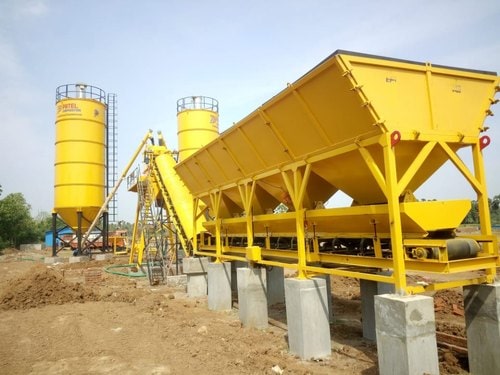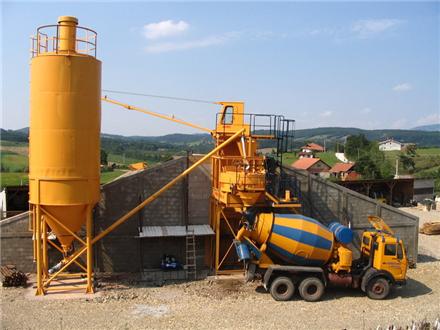Salimi Azar industrial machine
- Industrial conveyor belt
- Detergent powder production line
- Packaging filling machine
- Horizontal industrial mixer
Concrete batching is an industrial process used to produce concrete. In this process, various concrete components such as cement, sand, aggregate and water are mixed with precise proportions to obtain the final concrete. This process includes several steps that we will explain below:
. Preparation of raw materials: In this step, the raw materials of concrete, including cement, sand, aggregate and water, are kept in place and ready to be used. Usually, cement is received in bags and stored in the cement warehouse. Also, sand and aggregate are transported from mines or manufacturing plants to the concrete production site.
. Mixing: In this step, raw materials are mixed together in precise proportions. This work is done by a concrete batching machine, which has different tanks for storing raw materials. In this device, the raw materials are transferred automatically and with exact proportions to different tanks, where they are mixed together.
Concrete transfer: After mixing, the concrete is transported to the destination by the concrete station. This work is done by concrete trucks that have vehicle tanks.
. Pouring concrete: At this stage, concrete is poured into different molds. Usually, molds such as square, circular, etc. concrete molds are used for pouring concrete.
. Smoothing and shaving: After concrete is poured, concrete dries and hardens. At this stage, tools such as concrete grinding machines and concrete grinding plates are used to smooth and shave the concrete surface.
In general, concrete batching is an industrial process used to produce concrete and includes various steps such as preparation of raw materials, mixing, concrete transfer, concrete pouring, smoothing and scraping.

What is concrete batching? The process of measuring materials for preparing concrete mix is known as concrete batching. Batching can be done in two ways: volume and weight batching. Batching should be done properly to obtain a quality concrete mix.

List:
Concrete batching methods
1. Volume batching
2. Weight batching
Concrete batching methods
1. Volume batching
In volume batching, materials are measured by volume. This is a less accurate method of batching.
Measuring boxes or known volume measuring boxes are used to measure materials.
Cement is taken in the form of a bag, the volume of one bag of cement (50 kg) is 35 liters.
The volume of the used gauge box is equal to the volume of a 35-liter bag of cement or multiple times.
Gauge boxes are generally deeper, have a narrow top, and are made of wood or steel or iron.
The volume of fine aggregates of different sizes and coarse aggregates are measured separately by these measuring boxes.
Water is measured using a water meter or water cans with a specific volume.
To make a concrete mix with a ratio of 1:1:2 according to volumetric batching, one bag of cement (35 liters), 1 gauge box of fine aggregate (35 liters) and 2 gauge boxes of fine aggregate (70 liters) should be taken. If the ratio of water to cement is 0.5, half of the volume of cement, which is 25 liters of water, should be taken.
- Weight classification
In this method, materials are measured based on weight. This is the exact method of batching.
Weighing devices or other weighing equipment are used to measure the weight of materials.
Cement, fine aggregate, coarse aggregate and water are taken by weighing.
Weighing batteries are available in two types: mechanical butcher and electronic butcher.
In mechanical weighers, the weights are measured using a spring and gauge plate, and widely used equipment is used in batching weighing.
In electronic weighing, electronic scales and load cells supported by funnels are used to measure the weight of concrete ingredients.
The existing weighers may be manual or semi-automatic or fully automatic. The manual type is used for small concrete production jobs while the other two types are used for large concrete production.
In the case of semi-automatic weighing batching, the lid of the aggregate containers is lifted manually and is automatically closed after reaching the required amount in the weighing machine.
In fully automatic weighing, all steps are done automatically. The advantage of this type of equipment is that it also measures the amount of moisture in the aggregate and adjusts the amount of cement water required according to the moisture content of the aggregates.
To prepare a 1:1:2 concrete mixture using batch weighing, the measured amount of materials is 50 kg of cement, 50 kg of fine aggregate and 100 kg of coarse aggregate.
Batching weighing is the most accurate batching method compared to batching volume because it is difficult to find the exact volume of granular materials due to their empty space.
The presence of moisture in the aggregate should also be considered during batching. In case of fully automatic batching weighing, it can be considered, but volumetric batching is not suitable in such cases.
The compressive strength of the same concrete mixture in 7 days and 28 days for the weight batching mixture is higher than the volumetric concrete batching mixture.
Weight batching mix gives medium to very high slump while for the same proportion of mix in bulk batching slump varies from low to high.
Batching by volume does not require skilled workers, but batching by weight does.
The choice of batching method depends on the size of the project and the amount of concrete production.
The future of batching industry
Many operational characteristics of batchers have been improved in response to the increasing need to increase productivity and mixing of a batch.
The development of concrete batching has led to the introduction of computer control. Modern factories have dynamic displays, sensors and other control devices that ensure accurate feeding and mixing processes.




